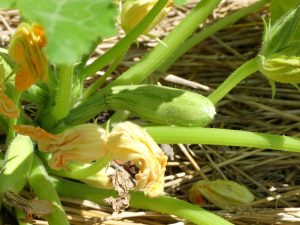Summer Garden Inquiries answered by Vijai Pandian, Horticulture Extension Educator

Summer Squashes mature quickly. Fruits will be ready to harvest within 4-8 days of the plant’s flowering.
When to harvest summer squash?
Summer squashes can mature quickly in warm weather and the fruits will be ready to harvest within 4 to 8 days after flowering. Harvest the summer squash when the fruits are tender, small to medium-sized, and it is easy to puncture the fruit skin with a fingernail. The seeds inside the fruit should also be soft and edible. Typically the elongated varieties should be harvested when the fruit reaches 2 inches or less in diameter and are about 6 to 8 inches in length. Scallop (patty pan) types are harvested when the fruits are about 3 to 4 inches in diameter.
What type of mulch is best for tomatoes?
Mulching during growing season benefits the tomato plant in many ways. Mulching helps in conserving soil moisture, smothers annual weeds, keep the soil temperature relatively cooler, and minimizes the soil splash carrying the fungal spores to the lower leaves. To mulch your tomatoes, use organic materials like clean straw, rice hulls, crushed corn cobs, shredded newspaper (black ink) around the base of the plants and between the rows to about 2-3 inches deep. Do not use treated grass clippings or any plant parts from black walnut, butternut trees for mulching.
Why my radish has more foliage growth but no root development?
Too much shade, hot weather, dense planting (seedlings not thinned at the proper distance apart) and over-fertilization can cause poor root growth in radish.
How to contain overgrown tomato plants without pruning its suckers?
Caging tomatoes is an effective way to support and contain overgrown tomato plants. Standard wire mesh cages sold at the garden centers need additional anchorage to support the plant and are not big enough to contain large size tomato plants. Gardeners can build their own tomato cages using concrete reinforcement mesh or hog pen fence molded into a cylindrical ring (3 inches diameter) with the bottom ends staked into the ground. These large cages provide better support to the indeterminate tomato varieties and any other overgrown tomato plants, can also installed in raised beds and its mesh size is large enough to allow easy harvest of the fruits inside the cage.



